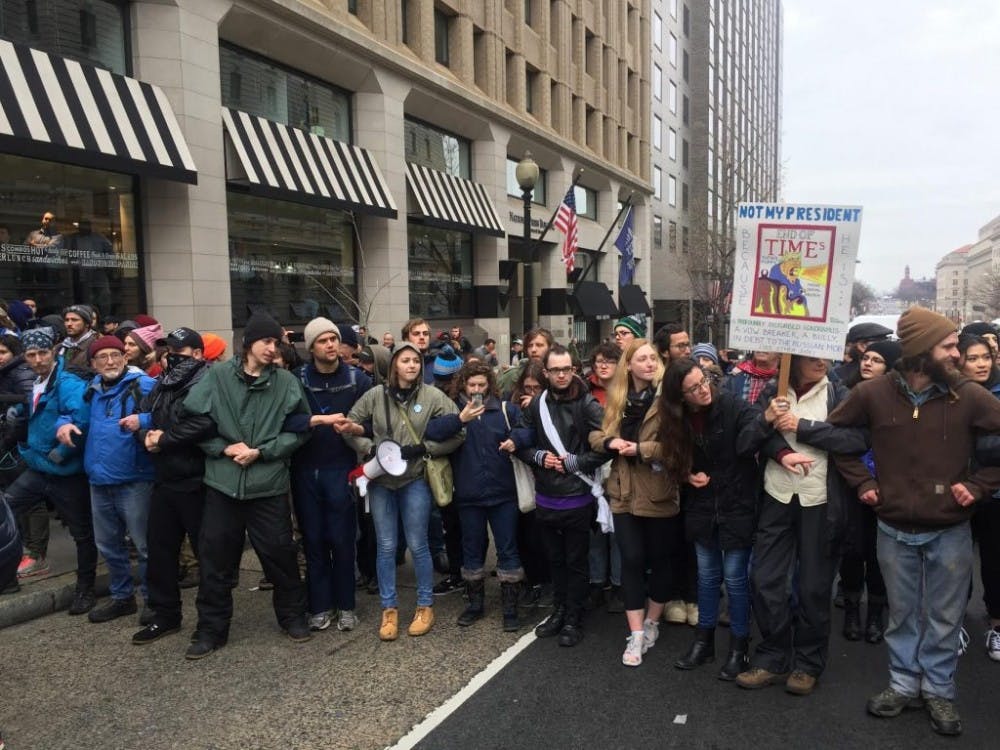Donald J. Trump was sworn in as the 45th President of the United States of America on Friday, Jan. 20.
Many attended the inauguration ceremony to celebrate Trump’s presidency, while others turned out in droves to protest what they considered harmful policy and rhetoric. The nation’s capital was a hive of political tension on President Trump’s Inauguration Day, as these two groups shared close quarters.
Among the sea of red baseball caps bearing the president’s campaign slogan were marches through the city’s streets, human blockades around entrances to the National Mall and small clumps of sign-wielding protesters who aimed to disrupt the ceremonial proceedings. They chanted slogans like “We are the popular vote!” and “This is what democracy looks like!”
Freshman Grace Troy explained that she didn’t go to D.C. to be a part of the protests but instead to witness the ceremony as a self-identified moderate liberal.
“I wasn’t exactly thrilled with the winner [of the election] but I thought being in Baltimore could be the closest I’m ever to D.C. during a presidential inauguration, so I wanted to go be a part of it and see the history that was this great American tradition,” she said. “I expected to feel this great wave of patriotism, but it was a bit underwhelming.”
Senior Allison Schingel also wanted to visit D.C. on Inauguration Day for its historical significance, but felt compelled to protest.
“I also knew that I’d feel powerless if I watched this ceremony from home,” Schingel wrote in an email toThe News-Letter. “I feel a large amount of dread about this presidential administration. I want to express that. I want to protest when I feel like it’s useful, for my wellbeing and the wellbeing of the nation.”
Freshman Kopal Bansal agreed that the demonstrations were important but also denounced the violent aspects of the protest.
“If you’re just holding up a sign or saying what you feel, that’s fine,” Bansal said. “But if you’re going and destroying people’s property, that should not be allowed. People smashed windows in a Starbucks, which was a little too far.”
Bansal said she was surprised to see the violence, particularly after a speech which she considered to be an attempt to unify the country after a divisive campaign.
“I liked how he was saying whatever color of skin you are, we all bleed the same red blood,” she said. “I feel like he was trying to unify people. Racist, far-right groups are taking Trump’s win as an excuse to be racist without being sorry for it, and that’s wrong. Trump should clarify there. He has to say that he’s not standing for racism. He was trying to bring people together, but I feel like he has to do a bit more.”
Troy was more critical of his speech, stating that she wasn’t impressed by what she saw as a series of empty promises and a continuation of the President’s campaign rhetoric, particularly on the issue of returning jobs to American workers.
“It was like being at one of his rallies, and he was still trying to be elected,” she said. “He’s promising all these things. I don’t know what his general plan is, but it’s a little scary. He talked a lot about bringing jobs back and making America an industrial hub again and I think that’s just not realistic. Those jobs aren’t coming back and it’s important that we start to realize that.”
Regarding the inauguration ceremony, Schingel said she was amused by the absurdity of the whole situation.
“I got home and checked social media and saw the inauguration celebrations and protests, and it all struck me as comical,” she wrote. “Trump is a garish, tacky figure. He has no class. The juxtaposition of himself and the seriousness and pomp of the inaugural celebrations was so stark. I could only laugh.”
Elaborating on some of the president’s dramatic policy changes, freshman Gigi Edwards expressed frustration with what she sees as a lack of education in many of Trump’s supporters.
“I don’t like to generalize, but I feel like a lot of his supporters are just taking his word and not seeing beyond that,” she said. “Even though they feel like they’re very knowledgeable about certain topics, they’re very close-minded about them. Trump and his supporters might claim to be concerned for our nation, and I think that they truly are, but they aren’t going to the right places to try and fix it.”
Edwards said that raising awareness through the marches is and will continue to be important to show that those who voted against the President still have a voice and will continue to push to fix things that the current administration won’t address.
“Being college students, even though a lot of the time we’re looked down upon by our elders, we still have a huge voice and we’re still being very affected by this,” she said. “A lot of people don’t care about midterm elections, but in two years that’s going to be a really big moment. That’s going to help with blocking some things that shouldn’t be going through and balancing the people that are in power.”
Junior Jessa Wais, who participated in protests in D.C. that day, spoke about how Hopkins students are in the unique position to motivate social change during the new administration.
“As college students, there is no better time than now to be active in our communities. It is easy to feel overwhelmed by the continuous cycle of disastrous news headlines, but it is also important to remember the power of organizing,” Wais wrote in an email to The News-Letter. “We live in proximity to Washington D.C. and Annapolis, and attend an institution that is a top employer in the state. As students, we have the power to make real changes that could improve real lives.”





